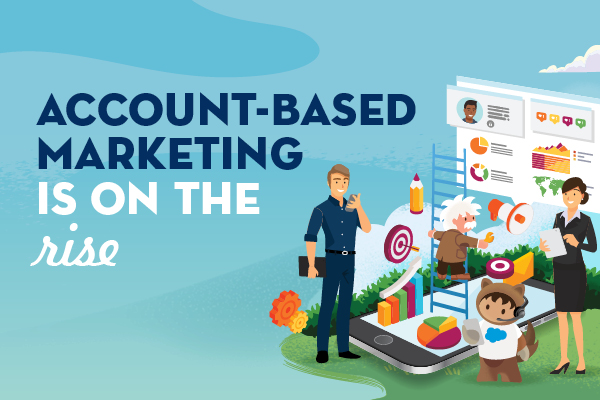Thinking about launching account-based marketing (ABM), or currently growing a fledgling program?
You’re not alone – our latest State of Marketing research found that nine out of ten B2B marketers have an ABM program, and 64% of those programs are less than five years old.
Aligning with customers’ needs has never been more important than it is now – as customers’ businesses and lives are challenged and reshaped, a deep understanding of changing needs coupled with an empathetic approach ensures you’re working towards the new future in a way that drives value for your customers and your business.
ABM integrates marketing, sales and service tightly to engage deeply and empathetically throughout the customer lifecycle – to meet customers’ high expectations of interactions that anticipate their needs.
Here, we’re sharing insights into ABM success including account insights, cross-functional collaboration, measurement, automation and budgets.
Gathering the right account insights
ABM that connects starts with account insights – deep knowledge of who you’re talking to, what they want to talk about, where and when – drawn from thousands of first- and third-party data sources. We can bucket those into industry, organisational and individual stakeholder insights.
For example, industry insights for a bank would include the current economic climate and industry outlook for financial services. We’d look at how the bank has been or is likely to be affected by macro trends and changes – the banking Royal Commission in Australia, digital acceleration based on COVID, open banking and disruption from fintechs.
Organisational insights would include looking at how the organisation is performing in its industry – is revenue growth outstripping competitors? How has its share price performed over time? Is it delivering against growth and transformation objectives? What are its strategic initiatives? This is also where we’d look at an organisation’s values, seeking partnerships that align with our values, and what the organisation is trying to achieve over the next 12 months. Looking at intent data – what are people from this organisation searching for on the internet right now and where are they most vocal? We look at the organisation’s view of technology – is it considered a short-term cost or a long-term strategic investment? This will point you to where your offering fits best in your customer’s world, not just your pipeline!
Recently we’ve also examined how organisations have been affected by COVID and how they have responded – whether they are seeing this as an opportunity for transformation and building resilience so they’re poised for longer-term growth.
Then there’s the stakeholder insights. I’m a strong believer that B2B ABM isn’t just about selling to a business – we’re ‘business to person’ marketers, or B2P. Look at who makes the decisions and who influences those decisions for your offering. How do they feel about your organisation or your solution? Are they an advocate, neutral or detractor? Do they already have relationships with anyone in your organisation? Titles can be deceiving – are they an approver or decision-maker? Where have they worked before, and what has been their focus? What has this organisation brought them in to achieve? What are their likes and dislikes? The last thing you want to do is invite someone to the AFL if they would prefer the Opera – although at the moment neither is likely.
Collaborate for growth
Those insights are all essential and are likely to require thousands of data sources. But my first port of call is always the sales team – engage early and often.
Ask your account executive what they want ABM to help them achieve with this prospect or ‘account’ in the next 12 months, where they are challenged and where they see most opportunity. Then give them something of value quickly, like an executive profile, messaging and value propositions for their account, or compelling and relevant content such as customer testimonials and thought leadership.
Throughout the year, continue seeking the sales team’s feedback and keep them engaged with regular updates including new insights on their accounts, as well as serving up engaging and relevant content. Remember every conversation should add value and never lose sight of your original insights. Make sure you’re taking their customers on a compelling and relevant journey, with marketing experiences that are tailored and special, to help deepen relationships as well as identify and progress sales opportunities. And measure and report back on that progress.
It’s also important to remember that ABM isn’t an island. Sales and marketing alignment is critical but, as ABM programs grow, alignment with the other elements of your marketing effort is also critical to realise efficiencies.
What to measure
So now you’ve got the sales and marketing teams thinking like your customers, it’s time to have the measurements and metrics conversation. You need to start early, but also accept that it may need to be fine-tuned as the ABM program unfolds.
The overarching goals of an ABM program are faster pipeline growth, higher close rates, larger average deal sizes and greater customer retention.
I always return to the 3Rs of ABM as my anchor for campaign measurement: revenue, relationships and reputation. They just work! While revenue is the ultimate shared goal, metrics and objectives don’t always need to be identical across marketing and sales for ABM to work really well – although we know that 75% of marketers in Australia and New Zealand do share common goals and metrics with sales teams.
Sales is ultimately measured against pipeline and revenue targets (even though customer satisfaction, NPS and lifetime value are carrying increasing weight), and the ABM team will happily work towards revenue targets but also on relationships and reputation – metrics can track speed to close deals with prospects in the pipeline, as well as measuring new pipe.
Typical relationship and reputation metrics include executive engagement in strategic and values-based initiatives, plus other marketing content and touchpoints including peer-to-peer networking with other customers, digital, social and virtual events – all of which help move customer sentiment from negative or neutral (‘do nothing’) to positive.
For example, how are you engaging with your prospect’s C-suite to partner on philanthropic projects close to their hearts? How many are advocates who speak at your events, in media or to your prospects, or attend your executive engagement programs?
Ahead of one recent event, we sent out 20 personalised customer-specific invitations to our key contacts at 20 of our different strategic high-value customers. The opening message, speakers and recommended viewing were tailored to each of their industries and organisations; the invitation was personally sent by their known account executive; and the timing was right – we saw a 70% lift in registrations compared to that customer’s registrations from a similar event last year.
A good list of ABM metrics might be:
- Increase in average deal size
- Pipeline acceleration / speed to close
- Increase in high-value executive engagement
- High Marketing Engagement Scores
- Increase in emailable contacts and responses, signalling they perceive value in your engagement
- Increased attendance at signature activities
- Actively engaging in one-to-one or one-to-few in-depth workshops
- Growing positive response to social amplification
- Receiving more RFP invitations or, better still, winning business without having to go to RFP
- Positive change in sentiment, e.g. from positive to advocate or neutral to positive
- Customer references / advocacy, with customers speaking about your organisation to other prospects and customers, or through other marketing mediums including events and media
Budget
Our latest State of Marketing research told us ANZ marketing teams are spending, on average, 17% of their total budgets on ABM. Those teams spending 17% or more of their total budget on ABM aren’t throwing money into something new – they’re strategic and seeing strong ROI.
At first, a marketing team might direct 10% of their budget to ABM – thinking of it as their innovation for the year. These are not short-term quarterly programs – budgets ultimately need to be based on what a business is trying to achieve in the medium and long term. A business with a well-defined, known and small target market might allocate a greater proportion of budget to ABM and spend less on brand awareness.
The actual amount you invest in ABM must come down to ROI. Understanding the revenue opportunity your sales team is chasing, and how ABM can move the needle in terms of deal size and speed to close will be the key decision points in determining the ABM spend.
Automation and scale
Marketing automation enables personalisation at scale. And the best way to drive true account-based marketing at scale is with fully integrated technology stacks.
As you look to roll out ABM programs across your organisation, targeting a large number of accounts in more segments or industry verticals, building the infrastructure, particularly technology and data infrastructure, becomes important. That forms the backbone for the information flows and collaboration that connect the marketing, sales and service functions, and enables the company to use data more effectively to deliver personalised customer engagement across the buying process.
Many organisations also spread the investment and operational commitment of ABM across a group of accounts that share common characteristics. This ‘1:few’ ABM approach engages strategic accounts at scale with a similar set of messages and activities, while maintaining an impactful level of account-specific personalisation across the final stretch of content production and activation.
As an example, segmenting 40 key accounts into five segments means your team will create value propositions and messaging five times, and build five journeys and landing pages instead of 40, yet these are still speaking to each organisation in the segment in a more relevant and tailored way than some traditional marketing efforts.
One hot tip: people buy from people
Technology for targeting and data insights are core, of course, but the basic premise at the heart of a successful ABM program is that people buy from people. Insight has to be actionable. Personal touches go a long way – custom invitations tailored to their interests, personalised event agendas and special VIP experiences built into the event that have been customised to their interests, customer testimonials from organisations they respect, a handwritten congratulations card, thank you notes. For enterprise-level B2B decisions, the decision-makers you’re dealing with are often betting their careers on what they’re buying – they need to feel well understood and well-cared for outside the sales relationship. You need to develop trust.
So any action you take, any message you send – use your data and your technology to make it relevant, make it engaging and make it special.
























